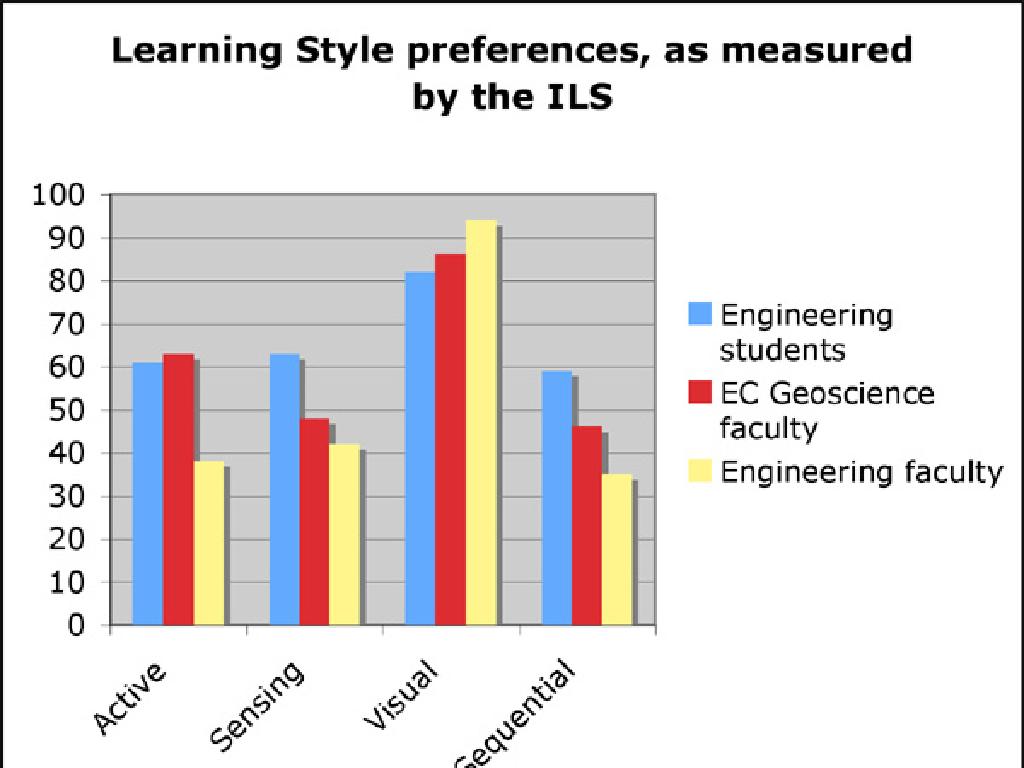Solve Equations With Variables On Both Sides
Subject: Math
Grade: Eighth grade
Topic: One-Variable Equations
Please LOG IN to download the presentation. Access is available to registered users only.
View More Content
Solving Equations with Variables on Both Sides
– Understanding equations with variables
– Variables represent unknown numbers in equations
– Recap: One-variable equation basics
– One-variable equations have one unknown we aim to find
– Preview: Variables on both sides
– Equations like 3x + 5 = 2x – 7 have variables on both sides
– Steps to solve these equations
– Combine like terms and isolate the variable to solve
|
This slide introduces the concept of solving equations that have variables on both sides, which is a step up from the one-variable equations the students are already familiar with. Start by ensuring that students understand what variables are and how they are used to represent unknown values in equations. Recap the basics of one-variable equations, emphasizing the process of isolating the variable to find its value. Then, preview the new concept of equations with variables on both sides, explaining that the goal remains the same: to isolate the variable and solve for its value. Provide a step-by-step guide on how to approach these equations, such as moving all variables to one side and constants to the other, and then solving for the variable. The next class will involve practice problems to solidify these concepts.
Solving Equations with Variables on Both Sides
– Real-world balanced scenarios
– Think of income vs. expenses or two sides of a scale
– Goal: Maintain equation balance
– Like a scale, we do the same to both sides to keep it level
– Example: Seesaw analogy
– A seesaw with equal weights on both sides stays level
– Solving step-by-step
|
This slide introduces the concept of equations with variables on both sides, which often represent real-world situations where balance is key, such as financial budgeting or physical systems in equilibrium. The goal in solving these equations is to maintain balance, which means performing the same operations on both sides of the equation. The seesaw is a relatable example for students, illustrating how both sides must be treated equally to remain balanced. When solving, we’ll demonstrate a step-by-step approach, ensuring students understand the importance of maintaining balance throughout the process. Encourage students to think of other balanced systems and how this concept applies to solving equations in mathematics.
Solving Equations with Variables on Both Sides
– Simplify equations on both sides
– Combine like terms and clear parentheses
– Shift all variables to one side
– Use addition or subtraction to get variables on one side
– Isolate the variable to find the solution
– Divide or multiply to get the variable alone
|
This slide outlines the steps to solve equations with variables on both sides, which is a key concept in algebra. Start by simplifying both sides of the equation by combining like terms and removing parentheses. Next, move all the variables to one side of the equation using addition or subtraction. This may involve moving terms from one side of the equation to the other, which changes their signs. Finally, isolate the variable by performing inverse operations such as multiplication or division. Ensure students understand that whatever operation is performed on one side of the equation must also be done to the other side to maintain balance. Provide examples for each step and encourage students to practice with different types of equations to build their skills.
Solving Equations with Variables on Both Sides
– Example Problem: 3x + 4 = 2x + 9
– Step 1: Subtract 2x from both sides
– Gives: x + 4 = 9
– Step 2: Simplify and solve for x
– Subtract 4, gives: x = 5
– Step 3: Check the solution
– Substitute x in original equation to verify
|
This slide presents a structured approach to solving equations with variables on both sides, aimed at eighth-grade students. Start with an example problem, 3x + 4 = 2x + 9, and guide students through each step. Step 1 involves getting all variable terms on one side, which simplifies to x + 4 = 9. Step 2 is to isolate the variable x, resulting in x = 5. Finally, Step 3 is to check the solution by substituting x back into the original equation to ensure both sides are equal. Emphasize the importance of checking the solution to confirm its correctness. Provide additional similar problems for practice and encourage students to explain each step as they solve them.
Solving Equations with Variables on Both Sides
– Example: 5x + 2 = 3x + 16
– Identify like terms on both sides
– Like terms: 5x and 3x
– Use inverse operations to isolate x
– Subtract 3x from both sides and subtract 2 from both sides
– Solve for x
– Simplify to find x = 7
|
This slide presents a structured approach to solving equations with variables on both sides. Start with an example problem, 5x + 2 = 3x + 16. Guide students to identify like terms, which are terms that contain the same variable raised to the same power. In this case, 5x and 3x are like terms. Next, apply inverse operations to both sides of the equation to isolate the variable x. This involves subtracting 3x from both sides to get 2x + 2 = 16, and then subtracting 2 from both sides to get 2x = 14. Finally, divide both sides by 2 to solve for x, resulting in x = 7. Encourage students to check their solution by substituting x back into the original equation to verify that both sides are equal.
Class Activity: Solving Equations
– Solve 4x + 7 = 4 + 2x
– Subtract 2x from both sides, then subtract 7
– Solve 6 + 7x = 3x + 14
– Subtract 3x from both sides, then subtract 6
|
This slide presents two practice problems for the class to solve together, reinforcing the concept of solving equations with variables on both sides. For Problem 1, guide the students to subtract 2x from both sides to get 2x + 7 = 4, and then subtract 7 from both sides to find the value of x. For Problem 2, instruct students to subtract 3x from both sides resulting in 4x = 8, and then divide by 4 to solve for x. Encourage students to show their work step by step and discuss any difficulties they encounter. Possible activities include pairing students to solve the problems, having volunteers solve the problems on the board, or creating small groups to discuss and solve the equations collaboratively.
Common Mistakes in Solving Equations
– Same operation on both sides
– Remember to add, subtract, multiply, or divide both sides equally
– Avoid combining unlike terms
– Terms with different variables or powers should not be combined
– Always check your solution
– Substitute the solution back into the original equation to verify
|
When teaching students to solve equations with variables on both sides, it’s crucial to highlight common errors. Emphasize the importance of maintaining balance by performing the same operation on both sides of the equation. Stress that only like terms can be combined; for example, ‘3x’ can be combined with ‘5x’ but not with ‘3y’ or ‘5’. Finally, instill the habit of checking their solutions by substituting the variable back into the original equation to ensure it holds true. This step is essential for verifying their work and understanding the concept of a solution.
Class Activity: Equation Race
– Pair up and solve equations
– First to finish correctly earns a point
– Discuss solutions with the class
– Understand variables on both sides
– Practice solving for x when it appears on both sides of the equation
|
This activity is designed to encourage collaboration and friendly competition among students while practicing solving equations with variables on both sides. Split the class into pairs and assign each pair a different equation to solve. The first pair to solve their equation correctly earns a point for their team. After the race, review each pair’s solution as a class to ensure understanding and correct any misconceptions. This will also help students learn from each other’s problem-solving strategies. Possible equations for the activity could include: 3x + 5 = 2x – 3, 7x + 4 = 5x + 16, or 6x – 2 = 3x + 7. Make sure to have a variety of equations to cater to different difficulty levels.
Homework and Next Steps
– Complete the 10-equation worksheet
– Study for the upcoming quiz
– Review today’s lesson on solving equations with variables on both sides.
– Next topic: Distributive Property
– We’ll explore how to solve equations that require the distributive property.
– Practice makes perfect!
|
For homework, students are tasked with completing a worksheet that includes 10 equations, all requiring them to solve for the variable when it appears on both sides of the equation. This will reinforce their understanding and prepare them for the quiz. The quiz will cover all the methods taught for solving these types of equations. Looking ahead, the next class will focus on solving equations that involve the distributive property, which is a critical skill for algebraic manipulation. Encourage students to practice regularly as this will help solidify their understanding and improve their problem-solving skills. Provide some example problems during class that involve the distributive property to give students a preview and help them prepare.






